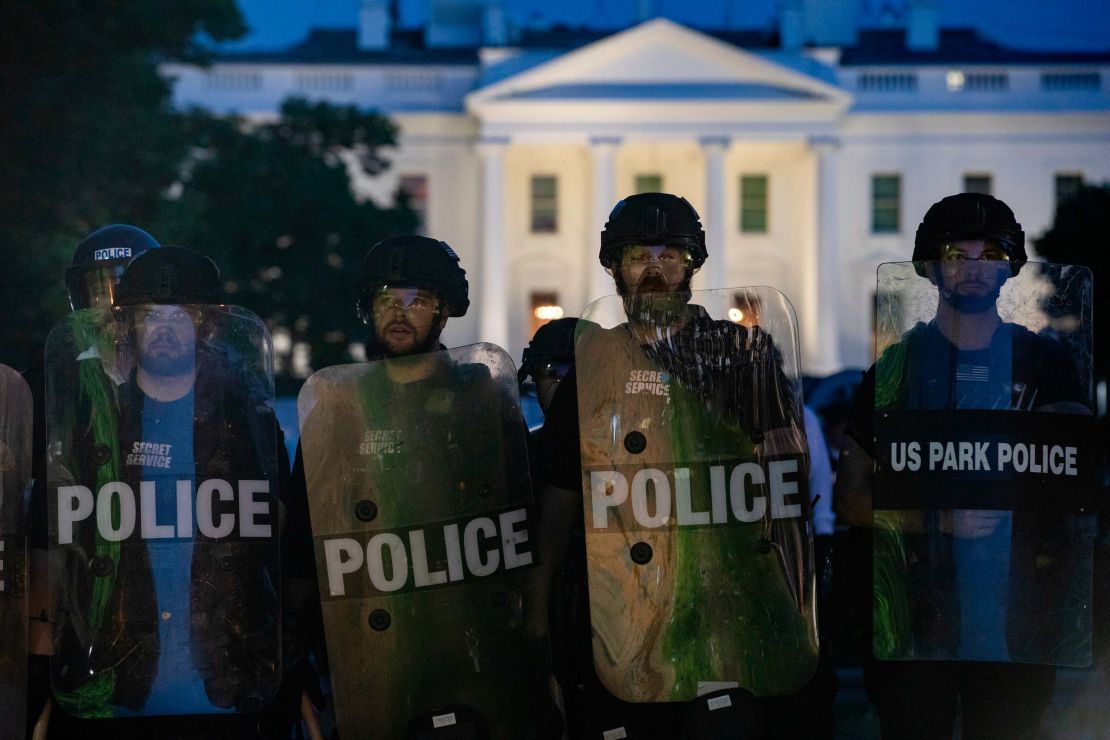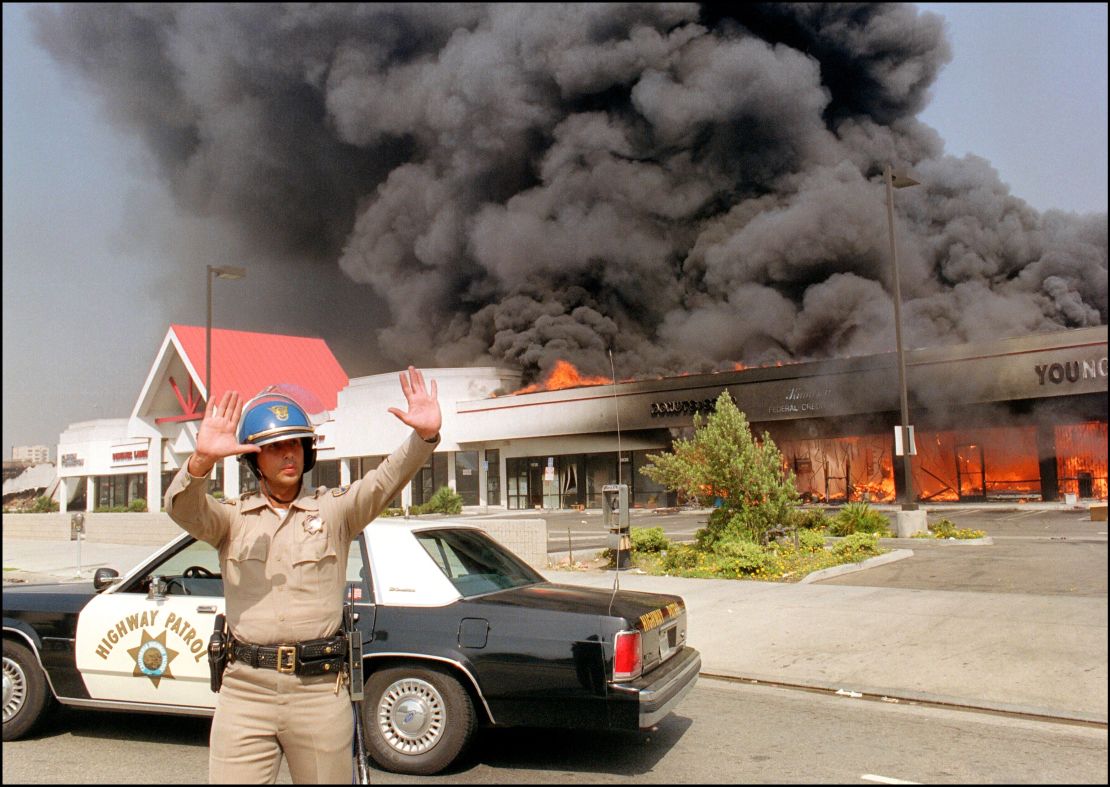In the wake of George Floyd’s death, Attorney General Bill Barr has found himself in a similar place he was in 28 years ago – serving as the country’s chief law enforcement officer and trying to quell a demonstration rooted in racial strife, using a similar type of force against Americans who had watched video of a black man brutalized by police.
After nearly three decades of societal change, Barr’s approach to protests sparked by concerns of racism hasn’t budged, focusing largely on putting an end to the violence – and not the peaceful message advocating for wide-reaching law enforcement reform.
It was Barr who on Monday evening ordered authorities – clad in military-grade guard and head shields, using some of the SWAT-like policing tactics generally considered to have been developed within the Los Angeles Police Department – to clear a crowd of protesters that had gathered near the White House, according to a Justice Department official.
Soon after, Trump addressed the press from the White House Rose Garden, threatening governors and local officials to quell the protests in their states or he would move to involve US military – something he doesn’t have the absolute legal authority to do. He subsequently walked past the area where protesters had just been cleared to take a photo with a Bible at a church damaged by demonstrators.
It was also Barr, serving as then-President George H.W. Bush’s attorney general, who helmed the federal response during 1992’s Los Angeles riots which came after four officers were acquitted of beating Rodney King. That was, in fact, the last time the Insurrection Act was invoked – the 1807 law allowing for the use of US military on US soil.

The similar incidents – and country’s top law enforcement officer at the heart of both – illustrate, in some ways, how little has changed in the intervening decades. The videotape of King’s treatment highlighted the racial divide both in LA and the country – and it spoke to the systemic racism between people of color – specifically black men – and law enforcement. And those same wounds are clearly driving continued – mostly peaceful – protests across the United States following Floyd’s death.
But compared to the riots of 1992, the current faces of some police units and demonstrators protesting Floyd’s death today are more diverse and multi-ethnic. And during the George W. Bush and Obama administrations, the Justice Department tried to hold some police departments accountable. Some departments were investigated and, when they were found to have violated constitutional rights, put under consent decrees. But in Trump’s Justice Department, some of the previous efforts to hold police accountable, including the consent decrees, were dismantled.
The Justice Department declined to comment on this story.
King was an unarmed black man who was brutally beaten by a group of white Los Angeles Police Department cops. The incident was captured on camera. A grand jury refused to indict the 17 officers who stood by and watched the beating. The four white officers charged with beating King were acquitted, and massive riots ensued. For many people of color, the outcome crystallized what they had already known: the system is biased against them, no amount of evidence makes a difference and the (white) people in power are willing to do whatever it takes to remain that way. After the acquittal, the Justice Department, under Barr, filed federal charges against the four officers for violating King’s civil rights. Two of the officers were convicted and eventually, the US Supreme Court upheld their reduced sentences. The other two officers were acquitted.

In his recollection of the LA riots for a presidential oral history project at the University of Virginia’s Miller Center in 2001, Barr described offering recommendations to Bush in the late spring of 1992 similar to actions taken by Trump in 2020 – activating the military and assembling federal forces to try and deescalate tensions.
In 1992, Barr largely blamed gangs for the violence in LA.
“Some people would probably disagree with what I told him, but I did lay a lot of it on gang activity,” Barr said in 2001.
“My basic take was that this was not civil unrest or the product of some festering injustice. This was gang activity, basically opportunistic,” he later said in the interview.
Perhaps there is one difference for Barr – who unlike in 1992 – seemed to acknowledge in late May of this year that there were festering injustices.
“The voices of peaceful and legitimate protests have been hijacked by violent radical elements,” he said in a statement in late May.
But in his time as attorney general under Trump, Barr’s Justice Department has all but abandoned broad investigations into policing practices. And last year, Barr also ordered that a case bringing federal civil rights charges against an officer involved in the death of Eric Garner be dropped.
The current protests, Barr and the Trump administration say, are being derailed by the Antifa and what Trump calls the “radical Left.” And unlike in 1992, Barr took the blame a step further, attempting to designate the self-described anti-fascists, Antifa, as a terrorist organization, despite having no apparent legal authority to do so.
“The violence instigated and carried out by Antifa and other similar groups in connection with the rioting is domestic terrorism and will be treated accordingly,” Barr said in his statement.
Controlling rioters
Back in 1992, Barr counseled Bush on how he could deploy federal forces to LA to assist what he said was the city’s “very small police force.”
Faced with issues deploying the National Guard to the area, Barr offered two other choices: deploying some 2,000 non-military federal forces to the area with the logistical help of Chairman of the Joint Chiefs of Staff Colin Powell or to activate the US Army.
“We had just gone through an exercise two years earlier in St. Croix, so I was very familiar with how to use regular Army in a domestic situation,” Barr told the Miller Center, apparently referring to the invocation of the Insurrection Act, in 1989, when it was used to confront looting on St. Croix following Hurricane Hugo.
“I understood all the code sections and what you had to do. … Basically the President has to issue a proclamation telling people to cease and desist and go to their homes. It’s sort of an antiquated statute. And then if they don’t cease and desist, you’re allowed to use regular Army,” Barr said.
He appeared to be referring to advising Bush to invoke the Insurrection Act to allow US soldiers to police US streets. Bush told Barr he would only use the military as a last resort, but eventually, armed forces would be sent in when he invoked the act through an executive order on the third day of rioting in LA
Two days after the order was signed by Bush, more than 1,100 Marines, 600 Army soldiers, and 6,500 National Guard troops were patrolling the streets of Los Angeles.
The riots did deescalate after the California National Guard, US military and federal law enforcement intervened. But when the riots came to an end, more than 50 people were dead and more than 2,000 were injured.
The riots left an indelible mark on Los Angeles and the LAPD. The city’s mayor commissioned an investigation into the department in what was called the Christopher Commission. The commission’s 228-page report found a pervasive pattern of excessive force by officers. Ten years after the riots, the LAPD began what Harvard researchers would later call “one of the most ambitious attempts at police reform ever attempted in an American city.”
And while the department is still not above reproach in many ways, in 2017, the diversity of the force had dramatically shifted. In 2017, the LAPD was just over 30% white, compared to being 60% white in 1992.
Despite the lessons learned from the riots, which took place nearly 30 years ago, Barr has maintained a similar plan to police crowds of demonstrators protesting police brutality in Minneapolis, Washington, DC, New York, Los Angeles and a slew of other American cities.
And in at least one major way, the Trump administration has attempted to up the ante.
Bush was reluctant to invoke the Insurrection Act until it was a last resort, but Trump hovered the threat of it above the heads of city and state leaders.
“If the city or state refuses to take the actions that are necessary to defend the life and property of their residents, then I will deploy the United States military and quickly solve the problem for them,” Trump said Monday in the White House Rose Garden.
Despite the threat, the act has limits. One section of the law suggests that states must first request help, but other portions of the Insurrection Act do not require a governor or state legislature’s okay, such as when the President determines the situation in a state makes it impossible to enforce US laws or when citizens’ rights are abridged.
In 1992, Bush only invoked the act when Republican California Gov. Pete Wilson and Los Angeles Mayor Tom Bradley called the White House asking for help. As demonstrations over Floyd’s death continue, several states have told the Pentagon they don’t need troops to deal with the protests.
Different approaches to protesters
Bush and Trump have also taken a different approach to direct engagement with protesters and the civil rights community.
According to Barr, Bush was “very much engaged,” speaking with “some civil rights leaders who were calling in.” Bush also took heat for waiting five days to visit LA, touring the city and meeting with Black residents.
But so far, neither Trump nor Barr have publicly interacted with demonstrators, activists or civil rights leaders since the start of demonstrations. And there’s no word yet on whether Trump would visit Minneapolis.
On Monday, Barr ordered security forces to clear peaceful protesters outside the White House, observing demonstrators from a distance within Lafayette Square, the park adjacent to the White House where demonstrators had previously gathered.
Security forces cleared out peaceful protesters with deterrents, such as pepper balls. Minutes later, Trump would walk across the area previously occupied by security forces and demonstrators to a nearby historic church, flanked by advisers and Secret Service, to pose for a photo with the Bible. The church, St. John’s Episcopal Church, had been damaged and set on fire the night before.
The Justice Department has declined to comment on the tactics used around of Lafayette Square, but said that if officers faced resistance in clearing the area they could use crowd control measures.
Barr was also seen walking around downtown Washington, DC, Monday night flanked by aides, security and Trump administration officials, speaking to forces on the streets of the nation’s capital.
And the demonstrations in 2020 are taking place across the country. But it’s unclear if or when Trump will visit the site of Floyd’s death in Minneapolis.
CNN’s Zachary B. Wolf and Evan Perez contributed to this report.








